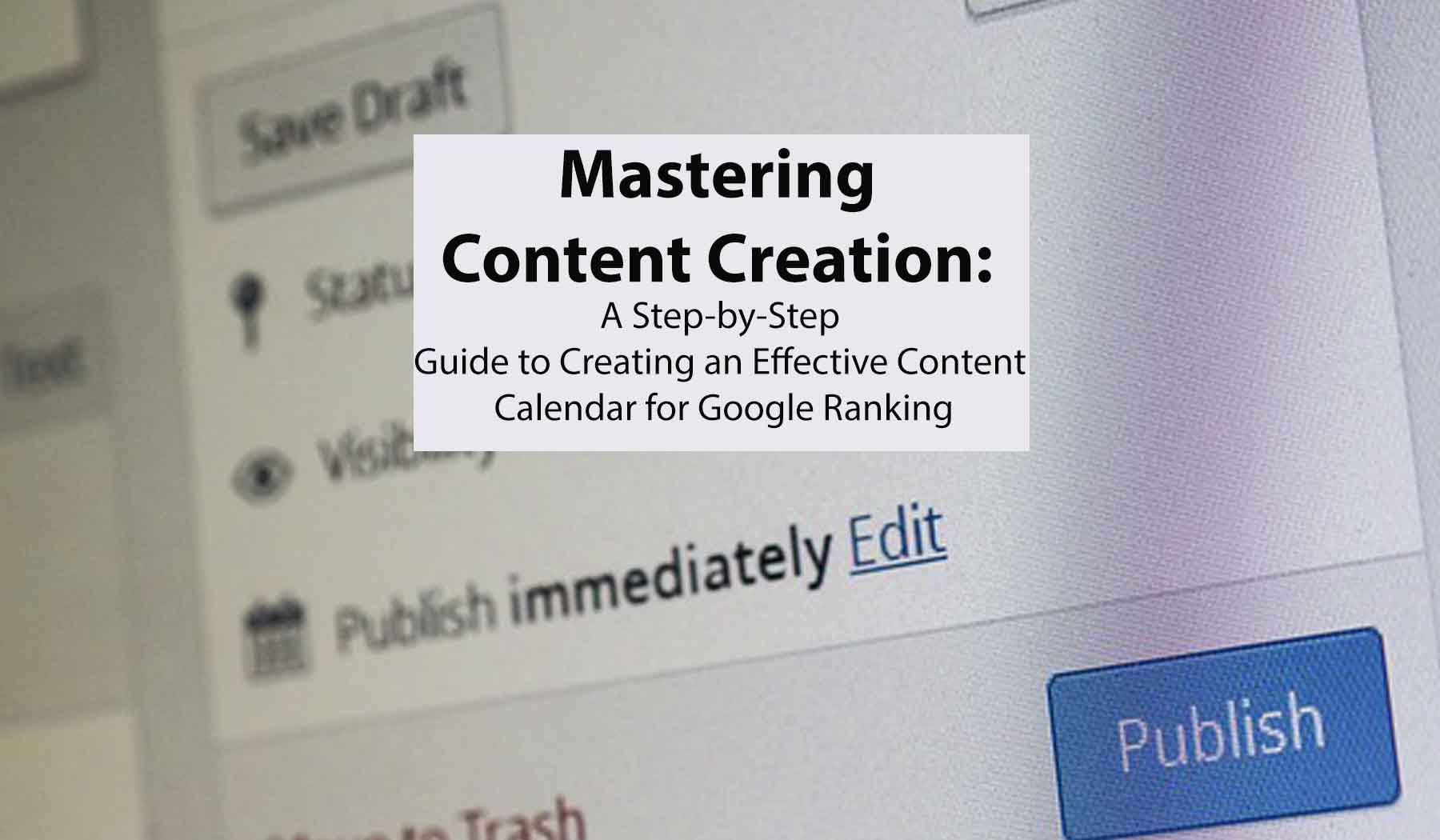Are you struggling to stay organized and consistent with your content creation efforts?
If so, it’s time to create a content calendar.
A content calendar is a valuable tool that can help you plan, organize, and schedule your content in advance, ensuring a smooth and consistent flow of engaging material for your audience.
In this comprehensive guide, we will walk you through the step-by-step process of creating a content calendar that will not only keep you on track but also rank on Google, driving more traffic to your website. So, let’s dive in!
1. Define Your Content Strategy and Goals
Before diving into the nitty-gritty of creating a content calendar, it’s crucial to establish a clear content strategy and define your goals.
Ask yourself the following questions:
- What is the purpose of your content? Are you aiming to educate, entertain, or inspire your audience?
- Who is your target audience? What are their interests, pain points, and preferences?
- What goals do you want to achieve with your content? Is it to increase website traffic, generate leads, or build brand awareness?
Having a solid understanding of your content strategy and goals will help you tailor your content calendar to meet your specific needs and align with your overall marketing objectives.
2. Identify Your Content Themes and Topics
Now that you have a clear understanding of your content strategy, it’s time to brainstorm content themes and topics that resonate with your audience.
Start by researching popular keywords in your industry using tools like Google Keyword Planner or SEMrush.
This will help you identify trending topics and ensure that your content aligns with what your target audience is searching for.
Consider creating a mix of evergreen content (timeless and always relevant) and timely content (related to current trends or events).
This will help you maintain a balance between long-lasting value and capturing immediate interest.
3. Choose Your Content Calendar Format
Next, decide on the format of your content calendar.
There are various options to choose from, including:
- Spreadsheets: This classic format allows for flexibility and customization. You can create a calendar using Microsoft Excel or Google Sheets, adding columns for dates, topics, keywords, content formats, and publishing platforms.
- Online Tools: There are several online platforms specifically designed for content planning and scheduling, such as Trello, Asana, or CoSchedule. These tools often offer collaborative features, making it easier to manage a team and streamline the content creation process.
- Content Management Systems: If you’re already using a content management system like WordPress or HubSpot, take advantage of their built-in content calendar features. This option allows you to seamlessly integrate your content planning with your publishing workflow.
Choose the format that best suits your needs and preferences, ensuring that it provides a clear overview of your content schedule.
4. Create a Monthly Content Calendar Template
Once you have chosen your preferred format, it’s time to create a monthly content calendar template.
This template will serve as the foundation for planning and organizing your content on a month-to-month basis.
Here’s what to include in your template:
- Dates: Start by adding the dates of each month, either in a row or column, depending on your calendar format.
- Content Titles: Fill in the content titles or working titles for each piece of content you plan to publish. Be descriptive but concise.
- Content Types: Indicate the format of each piece of content, whether it’s a blog post, video, podcast episode, infographic, or social media post.
- Keywords: Assign relevant keywords to each content piece to optimize it for search engines. This will help improve your ranking on Google and attract organic traffic.
- Status: Keep track of the status of each piece of content, indicating whether it’s in progress, ready for review, scheduled, or published. This will help you stay organized and ensure timely delivery.
- Publishing Platforms: Specify where each piece of content will be published. Whether it’s your blog, YouTube channel, social media platforms, or email newsletter, it’s essential to have a clear plan for distribution. Ensure that your monthly content calendar template is easily accessible and shareable with your team, if applicable. This will facilitate collaboration and keep everyone on the same page.
5. Plan Content Creation and Publication
Now that you have your monthly content calendar template, it’s time to start populating it with content ideas and scheduling them for creation and publication.
Follow these steps to plan your content effectively:
- Brainstorm Content Ideas: Refer to the list of content themes and topics you identified earlier. Brainstorm specific ideas for each piece of content, focusing on providing value to your audience and aligning with your goals.
- Assign Deadlines: Set realistic deadlines for content creation, taking into account the time required for research, writing, editing, and other necessary tasks. Be mindful of your team’s availability and workload if you’re working collaboratively.
- Consider Content Repurposing: Look for opportunities to repurpose existing content into different formats. For example, you can turn a blog post into a video or create social media snippets from an ebook. This allows you to maximize the value of your content and reach a wider audience.
- Balance Your Content Mix: Ensure a diverse mix of content types throughout the month to cater to different audience preferences. Alternate between long-form articles, short-form posts, videos, and other formats to keep your content engaging and varied.
- Add Buffer Time: Leave room in your content calendar for unexpected delays or additional revisions. Building in buffer time ensures that you have some flexibility in your schedule and reduces stress when unexpected obstacles arise.
6. Research and Optimize Keywords
To improve your ranking on Google and attract organic traffic, it’s essential to conduct keyword research and optimize your content accordingly.
Here’s how to do it:
- Identify Target Keywords: Use keyword research tools like Google Keyword Planner, SEMrush, or Moz to find relevant keywords for each piece of content. Look for keywords with a good search volume and low competition.
- Incorporate Keywords Naturally: Once you have identified your target keywords, incorporate them naturally into your content. Aim for a balance between optimization and maintaining readability and relevance.
- Optimize Metadata: Pay attention to optimizing your metadata, including meta titles, meta descriptions, and alt text for images. These elements provide valuable signals to search engines and influence your search engine ranking.
- Monitor Performance: Regularly monitor your content’s performance using analytics tools like Google Analytics or social media insights. This will help you identify which keywords are driving traffic and engagement, allowing you to refine your content strategy.
7. Consistency and Adaptability
Creating a content calendar is not a one-time task; it’s an ongoing process that requires consistency and adaptability.
Here are a few tips to help you stay on track:
- Stick to Your Schedule: Adhere to your content calendar as closely as possible. Consistency is key to building a loyal audience and maintaining their interest.
- Be Flexible: While it’s essential to follow your content calendar, be prepared to make adjustments when necessary. Stay open to incorporating new ideas, responding to current events, or addressing emerging trends. Your content calendar should be a guide, not a rigid plan.
- Regularly Review and Update: Set aside time each month to review the performance of your content, assess your goals, and make necessary adjustments to your content calendar. This ensures that your strategy remains relevant and effective.
- Engage with Your Audience: Pay attention to feedback and engagement from your audience. Monitor comments, messages, and social media interactions to understand their preferences and interests. Incorporate their feedback into your content calendar to create content that resonates with them.
- Stay Ahead with Content Ideation: Dedicate time to consistently brainstorm new content ideas. Stay updated on industry news, trends, and changes in your target audience’s needs. This proactive approach will help you stay ahead and create relevant and timely content.
8. Promote and Amplify Your Content
Creating great content is only half the battle; promoting and amplifying it is equally important.
Here are some strategies to maximize the reach and visibility of your content:
- Social Media Promotion: Leverage your social media platforms to share and promote your content. Craft engaging captions, use relevant hashtags, and encourage your audience to share and engage with your posts.
- Email Marketing: Incorporate your content into your email marketing strategy. Send regular newsletters to your subscribers, highlighting your latest content and providing valuable insights or additional resources.
- Collaborate with Influencers: Partner with influencers or industry experts who align with your brand. Collaborative content or influencer shout-outs can expand your reach and introduce your content to new audiences.
- Guest Posting: Seek opportunities to contribute guest posts on relevant industry websites or blogs. This allows you to showcase your expertise, reach a new audience, and generate backlinks to your own content.
- Optimize for SEO: Ensure that your content is optimized for search engines by using relevant keywords, meta tags, and descriptive URLs. This will help improve your organic search visibility and drive more traffic to your website.
9. Analyze and Refine Your Strategy
Regularly analyze the performance of your content calendar and make data-driven decisions to refine your strategy.
Here’s how to do it:
- Track Metrics: Use analytics tools to track key metrics such as website traffic, engagement, conversion rates, and social media performance. Analyze these metrics to identify patterns and insights about what’s working and what’s not.
- Evaluate Audience Feedback: Pay attention to comments, feedback, and user-generated content related to your content. Understand your audience’s preferences, pain points, and interests to refine your future content strategy.
- A/B Testing: Experiment with different content formats, headlines, calls-to-action, or distribution channels. Conduct A/B tests to identify what resonates best with your audience and drives the desired results.
- Iterate and Optimize: Based on your analysis, make iterative improvements to your content calendar. Fine-tune your content themes, distribution channels, and publishing frequency to maximize engagement and achieve your goals.
Creating and maintaining a content calendar requires continuous effort and adaptation.
Stay proactive, stay informed, and stay connected with your audience to ensure that your content remains valuable and impactful.
An Invaluable Step
Creating a content calendar is an invaluable step toward achieving consistency, organization, and success in your content marketing efforts.
By following the steps outlined in this comprehensive guide, you’ll be able to develop a well-structured content calendar that not only keeps you on track but also helps your content rank on Google and attract a larger audience. Remember, consistency, quality, and adaptability are key. Embrace the power of planning, and watch your content strategy flourish. Below is an outline template to get you started. Happy content creation!
Content Marketing Plan Template Goals/Objectives 1. 2. 3. Target Audience Demographics: Interests: Pain Points: Content Themes 1. 2. 3. Content Formats 1. 2. 3. Distribution Channels 1. 2. 3. Content Calendar Month/Date Content Title Content Type Keywords Publishing Platform Status Promotion Strategy 1. 2. 3. Metrics and Analysis Key Metrics to Track: Analysis and Optimization:








